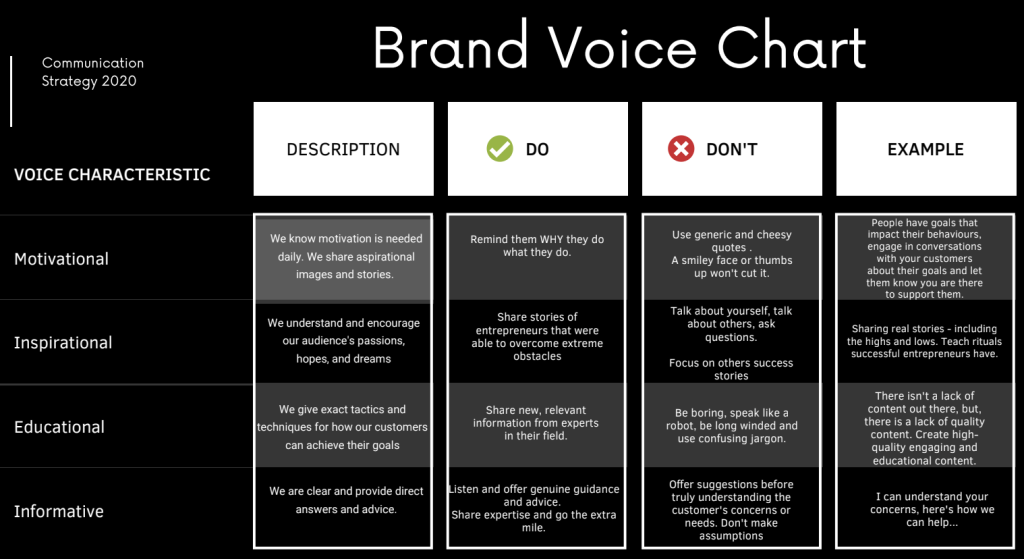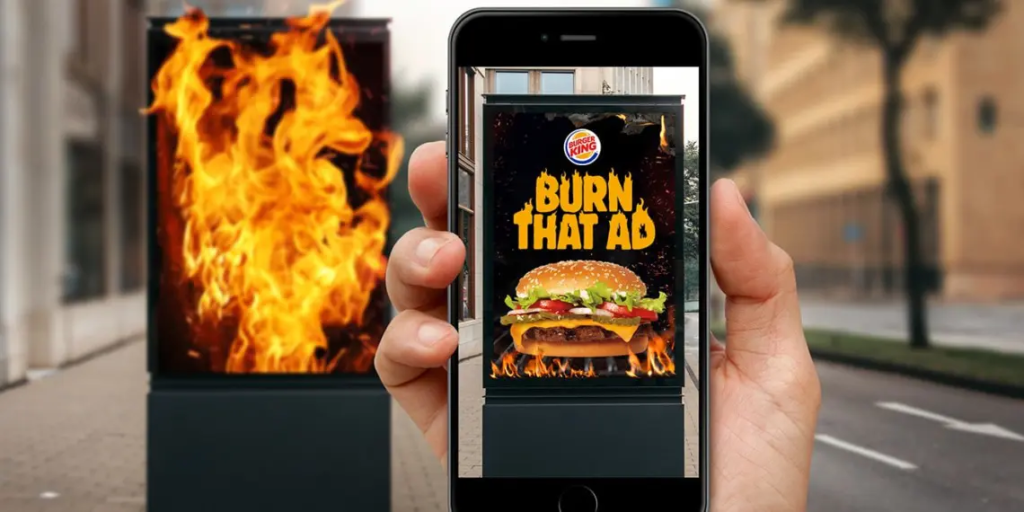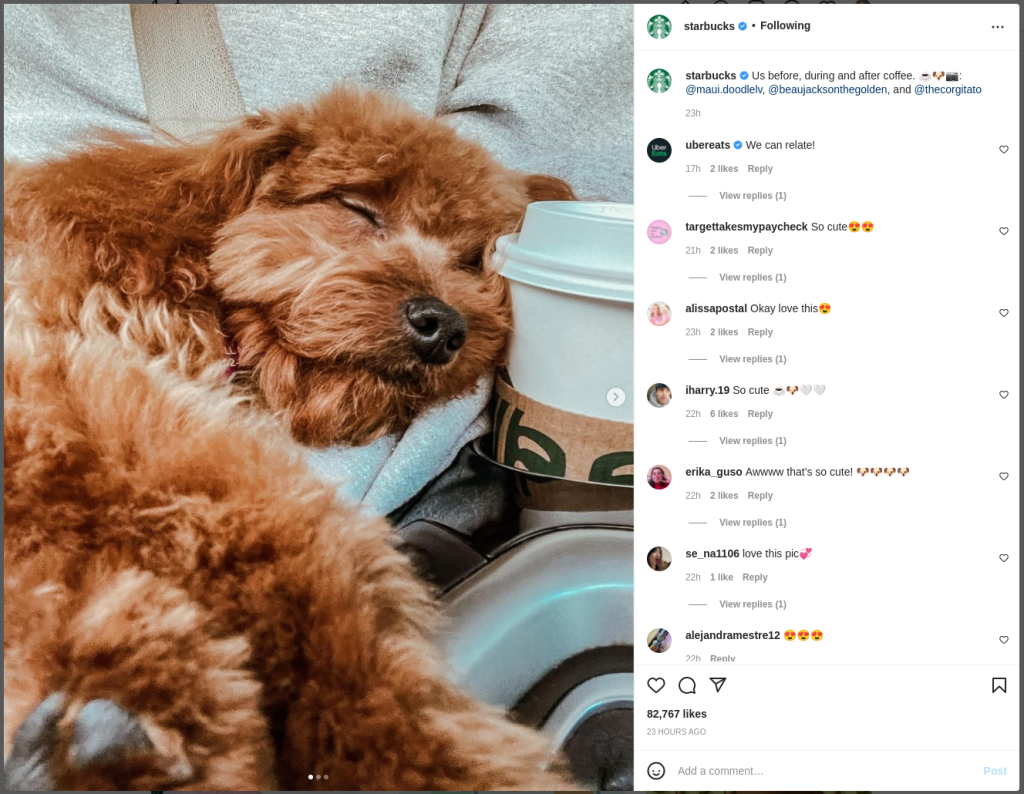Tone of Voice: What Does Your Brand Need to Become Identifiable
«A fast-growth company with an exclusive high-quality product and a custom-tailored approach.» Can you recognize the brand? You can insert any company name into this description, and here it is — a clothing brand, a grocery brand, a building materials brand, etc. Bloomberg calls such companies «blands», which means faceless startups. These brands are lookalikes. They also copy the style of their well-known competitors. For example, some brand tries to look like Google, but blends in with the others instead. As a result, consumers do not distinguish between these brands.
Quick Links
How does a company avoid being in a «blands» list? Work on Tone of Voice — the brand’s individual communication style. Read this piece to find out why ToV is important and how to create it.
What is Tone of Voice?
Tone of Voice is a unique style of brand communication with the audience that covers all channels: social networks, corporate blog, email, telephone, company office. ToV is a set of rules on how to talk to users. It is one of the crucial aspects of your brand appeal.
We can also speak about the term «brand voice».
Let’s learn how to differentiate between the two.
Brand voice is a broad term. It’s a constant with recognizable characteristics: words, syntax, devices that distinguish your brand from others. Brand voice shows the brand identity and its values.
Let’s imagine a girl named Alice. She has a nice soft voice. She doesn’t use swear words and often says «exactly» and «good», and she always uses a slightly rising intonation. If Alice were a brand, her voice would be recognized by these characteristics.
Tone of voice is the rules on the use of voice in a particular situation. It shows the emotions of the speaker (brand): joy, enthusiasm, sympathy, etc. The tone of a text, phone conversation or offline communication remains within the brand voice. However, it may differ depending on the channel: on the website the tone will be more restrained, while on Instagram it will be more enthusiastic. Despite the tone, the brand voice is always recognizable.
Let’s imagine that Alice is annoyed with somebody. Usually, in a situation like this, she speaks louder, and the pitch of her voice gets a little bit higher. However, she still doesn’t use swear words, but her «exactly» becomes sharper. Do we recognize Alice’s voice? Of course.
So the two above-mentioned terms are rather similar. However, «brand voice» has a broader meaning and includes the term «tone of voice».
Why does your brand need its own Tone of Voice?
Tone of voice is not just a trend. It’s a long-term strategy that:
Humanizes your brand
According to the personal approach in a brand study, people perceive companies as individuals and since ancient times have endowed inanimate objects with the features of animate ones. Today, people endow brands with some human traits. We judge people by their appearance, personality traits, actions, and we do the same with brands — we judge them by their design, communication style and the product itself.
Increases awareness and helps to stand out from the crowd
The more different you are, the more likely you are to become recognizable.
Let’s imagine design studios A, B and C. Which one is a better choice? You can see the similar information on all the websites — modern design, custom-tailored approach and creativity. But there is studio D, which is described like this:

«Wild ideas» and «technocratic company» sound catchy. This brand is confident, bold and straightforward, and it differs from other more restrained businesses.
This is the tone of voice of Art. Lebedev Studio, which adopts its founder personality traits.
Enhances credibility and builds a deeper emotional connection
Consumers perceive the brand as an individual and compare its characteristics with their own. If they are similar, the person stays with the brand.
Helps to convey values
81% of users state that it is important for them to buy from brands that match their values. ToV conveys the nature of the brand — its mission and values.
An example of values conveyed by ToV (IKEA). The brand is about simplicity, so there are no lengthy and complicated descriptions on the website.

Increases profits
Consistent brand representation increases revenue by 23% on average. You should constantly work on ToV. It does not bring immediate results, but in the end, it gives your company regular customers and fans of the brand.
How to create your brand’s tone of voice?
It’s better to develop your ToV when you start a business. However, it doesn’t always work out that way. Sometimes it takes time to create real values. Therefore, it is possible to decide what the company’s voice will be at any stage of its development.
Creating Tone of Voice: A Step-by-Step Guide
- Define the target audience
ToV helps to speak the same language with your target audience. Who are these people? Study their demographics, geography, gender, age, interests, social media, methods of communication, tastes.
- Set goals
Define the communication goals through ToV. What action should your customer do after your interaction? Make a purchase, join the community of like-minded people, get involved in your content, get inspired, and so on.
- Make a list of values
Remember what your company is about. Here are some questions that will help you:
- Why was your brand created?
- How does it help people?
- How is it different from your customers?
- What are your unique features?
- How would you like to be perceived?
- What would you never do in communicating with the audience?
- Define the rules of communication
Make a list of what is allowed when communicating in your company, and what is prohibited.
It’s better when ToV is not only for your customers, but also used within the company. Take into account the rules of employee communication.
For example:
– We stick to informal communication, even with significantly older colleagues.
– We always say «hello» to our customers.
– We do not use such words as «awareness», «mission», etc.
- Describe the brand as a person
Imagine your company as a specific person. Describe the character, appearance, manner of communication, beliefs. It’s useful to ask the audience how they would imagine your brand if it were a person.
A youth clothing store can be a stylish and confident girl, who does sport, recycles plastic and travels a lot. She is goal-oriented, values her time, speaks quickly and often uses words from the digital world: cringe, insta, etc. She has short hair, and she likes comfy clothes: sweatshirts, oversized hoodies with bizarre prints. She likes tote bags and chooses a bicycle instead of a car.
This description helps us to understand how this brand communicates. Will this girl use the official style in her everyday speech? No, she will rather choose a simple and concise, but still expressive style.
- Conduct an audit
Analyze all channels of communication with your customers. These questions will help:
- How is your brand communicating now?
- What forms of address do you choose? Do they match everywhere?
- What words and grammatical constructions do you use most often?
- What should be removed from your communication style? Stop-words, verbose and incomprehensible sentences.
- What does not match with your brand values?
The results may surprise you. For example, you can find out that you use different ToV in your posts on social media and correspondence with customers.
- Describe your tone of voice
Creating communication boundaries. Can your brand be funny or not? To what extent can your brand be bold? Nielsen Norman Group developed a framework with four primary tone-of-voice dimensions:
- funny vs. serious;
- formal vs. casual;
- respectful vs. irreverent;
- enthusiastic vs. matter-of-fact.
In the framework table, specify the option that is closer to your brand. The middle cell is neutral. For example:

Describing ToV in more detail. Here Nielsen Norman Group also simplified the task and offered 37 words to choose from:

It is not necessary to use only these words, it is just an example. You know better how to describe your own brand.
Explaining the meaning of each definition. For example, what is «nostalgic»?
You can use the formula: «We…, but not… .»
Examples:
We are respectful, but not ingratiating.
We are friendly, but not overfamiliar.
We are bold, but we do not offend customers even with rudeness on their part.
- Give examples
Make a guideline for your ToV with detailed examples, show good and bad ones. You can also add a comment to each example.

- Test out your ToV
Share your observations with the team and see if your theory matches reality. Explain why your company needs these rules? Make ToV accessible to everyone. Perhaps some parts of your theory won’t match reality. Don’t be afraid to make edits.
Common mistakes when working with tone of voice
- Don’t copy someone else’s ToV
There is a chance to disgrace yourself, and in the worst case, you can be accused of plagiarism. People will always notice that your brand tries to copy another one. Don’t try to copy Google, for instance, be yourself.
- Don’t use ToV in all communication channels
Your customers usually expect the same communication style in all channels they use.
Let’s imagine a clothing store that sticks to a romantic and friendly tone in social media. Its social media manager encourages users to text at any time and drop by for a coffee. However, their personal messages sound indifferent. Their physical store is no better — bored salespeople who look down on you. How do the customers feel? Of course, they feel disappointed and cheated.
- Dramatically change the style of communication.
If you suddenly switch to informal «hi there» from official business style, your audience will be confused. Give the audience some time, make changes gradually, explain what is happening and why.
Tone of voice: examples of brands
Burger King
You can’t just write a piece about ToV without mentioning this brand.
The brand uses youth slang and colloquial words. While McDonald’s is a family restaurant, Burger King is your bro who likes edgy humour.

The brand language is concise. They don’t use long incomprehensible sentences. Everything is as clear as possible.

Burger King is a bold brand, but it is not disrespectful. There is both sympathy and irony in their responses. However, the brand doesn’t use such phrases as “we apologize for the inconvenience caused…”

Starbucks
The idea of a coffee shop with a pleasant atmosphere and a cup of coffee with your name on it sets the tone of brand communication.
The mission of the company is «to inspire and nurture the human spirit — one person, one cup and one neighbourhood at a time». Its ToV helps people to have a pleasant experience. There is no excessive expressiveness in the tone.

Basic principles of Starbucks are inclusivity, presentability, collectivity, interactivity and unobtrusiveness. The brand actively interacts with subscribers.
It feels like Starbucks is telling a story, creating images in the user’s head. This is how the description of the company on the website begins: «Our story begins in 1971 along the cobblestone streets of Seattle’s historic Pike Place Market. It was here where Starbucks opened its first store, offering fresh-roasted coffee beans, tea and spices from around the world for our customers to take home.»

BMW
This brand is about presentability, but at the same time about simplicity and emotion. It would be strange for a manufacturer of expensive cars to express emotions provocatively. «Sheer driving pleasure» is a slogan of the company, which clearly conveys the essence of the brand.
BMW’s communication style is usual for expensive products — long and expressive phrases.

The brand is not afraid of using such words as «exceptional» and «powerful». BMW speaks like a confident person who values comfort.
Conclusion
Tone of voice conveys brand values, determines the style of communication with the audience. It’s important to use the same ToV in all communication channels so as not to confuse your customers.
Do not copy someone else’s tone of voice or dramatically change the style of communication — the audience may get confused.
Tone of voice is not just a trend, it’s a strategy that makes faceless brands unique, enhances credibility, helps to distance your brand from competitors and humanizes it. ToV helps your company to get more revenue.
Why WooCommerce is the Best Choice for Your Online Store?
WooCommerce stands out as a top option for anyone looking to build an online store. This platform…
0 Comments8 Minutes
How to Use AI-Powered SEO Tools for WordPress eCommerce
SEO is a critical factor in the success of any e-commerce WordPress store. As competition…
0 Comments11 Minutes
Why Short-Form Videos Are the Future of Content Marketing
Your Instagram customers spend over 50% of their time watching short-form videos and reels. Rather…
0 Comments12 Minutes
The Role of Digital Marketing in Business Growth
Online marketing touches every aspect of a business, whether it is initiating the idea or for an…
0 Comments3 Minutes
AI Meets Authenticity: Balancing Automation and Human Touch in Content Marketing
Is your brand starting to sound like a robot? In a world where algorithms write faster than any…
0 Comments8 Minutes
Essential Tools for Enhancing Web Design and UX Hosting
Have you ever visited a website that felt slow, clunky, or confusing? A website that is poorly…
0 Comments11 Minutes
How a Mini Cart Transformed My Store’s Shopping Experience
Okay, real talk—running an online store is hard. You think you’ve got everything figured out, you…
0 Comments9 Minutes
Balancing Your Security Initiatives With Industry Compliance Requirements
Managing a business today comes with a number of daily battles that need to be fought. Resources…
0 Comments11 Minutes








